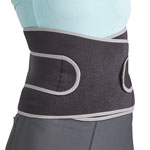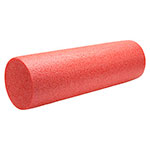The main muscles of the back and spine are the rectus abdominus, internal and external obliques, quadratus lumborum, multifidus, sternocleidomastoid, and erector spinae. Although not strictly back muscles, the abdominal and core muscles are very important for supporting and moving the spine.
The spine consists of 24 vertebrae, 7 cervical (neck), 12 thoracics (chest), 5 lumbar (lower back), 5 fused bones of the sacrum, and 4 fused bones in the coccyx or tailbone.
Back muscles
The following are muscles of the back:
Erector Spinae
The erector spinae (sometimes known as sacrospinalis) is often described as a group of three different muscles called iliocostalis (lateral or outer layer), longissimus (middle layer), and spinalis (inner, medial layer). Erector spinae consists of lots of small fibres which are situated very close to the spine.
Origin & insertion
It originates from the posterior crest of the ilium, lower posterior surface of the sacrum, lower 7 ribs, spinous processes of T9-L5 and the transverse processes of T1-12.
It inserts into the angles of the ribs, transverse processes of all vertebrae and the base of the skull.
Joint actions
Extension of the spine. Lateral flexion (side-bending) of the spine. Maintains correct curvature of the spine.
Innervation
Dorsal rami of cervical, thoracic and lumbar spinal nerves.
Example strengthening exercises – Dorsal raises.
Example stretches – Back arch stretch.
Internal Obliques
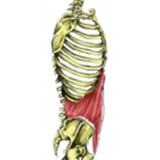
The internal obliques wrap around the waist and insert into the linea alba, a cord-like strip of connective tissue running down the centre of the abdomen. They help to side bend and twist the body.
- Origin – Iliac crest.
Inguinal ligament.
Thoracolumbar fascia. - Insertion – Lower 3-4 ribs.
Linea alba. - Actions – Contraction of one side alone laterally bends the trunk to that side and rotates the trunk to the other side. Compresses the abdomen and supports the abdominal viscera.
- Innervation – Ventral rami of thoracic nerves. Ilioinguinal nerve. Iliohypogastric nerve.
- Daily uses – Raking leaves.
- Example strengthening exercises – Twisting crunches.
Transversus Abdominis
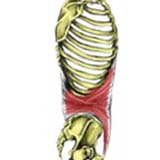
Transversus Abdominis is often abbreviated to TVA. This is a very important core muscle that is vital in maintaining good posture. Activities such as Pilates focus on the contraction of the TVA.
- Origin: Front of the iliac crest.
Inguinal ligament.
Costal cartilages of the lower 6 ribs.
Thoracolumbar fascia. - Insertion: Linea alba.
- Actions: Compresses the abdomen and supports the abdominal viscera.
- Innervation: Ventral rami of thoracic nerves. Ilioinguinal nerve. Iliohypogastric nerve.
- Daily uses: Maintaining good posture.
- Example exercises: Core contraction exercises.
- Related injuries: Lower back pain.
Sternocleidomastoid
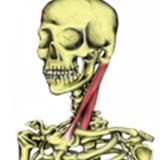
Sternocleidomastoid (SCM) can clearly be seen when you turn your head to one side, on the opposite side of the neck.
- Origin: Anterior surface of the upper sternum.
Inner part of the clavicle. - Insertion: Mastoid process (behind the ear).
- Actions: Contraction on both sides: Neck flexion.
Contraction on one side only: Laterally flexes (side bends) to the same side and rotates to the other side. - Innervation: Accessory XI nerve.
- Daily uses: Looking at the floor.
Looking over your shoulder.
Holding the phone between your ear and shoulder. - Example stretches: Neck rotation stretch.
Splenius
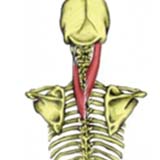
Splenius is often divided into two muscles, splenius capitus (those fibres which insert on the skull) and splenius cervicis (those that insert onto the cervical transverse processes of the spine).
- Origin: Lower half of the ligamentum nuchae.
Spinous processes of C7-T5. - Insertion: Transverse processes of C3-7 Base of the skull.
- Actions: Head and neck extension.
Contraction of one side laterally flexes and rotates the neck to the same side. - Innervation: Posterior rami of the lower cervical spinal nerves.
Lateral branches of the posterior rami of the middle and lower cervical spinal nerves. - Daily uses: Looking up at the ceiling.
Looking over your shoulder. - Example stretches: Lateral neck flexion stretch.
External Obliques
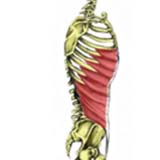
The obliques wrap around the trunk on each side to form our waists and join to the linea alba, a band of connective tissue running down the front of the abdomen. They help us to side bend and rotate the body.
- Origin – Lowest 8 ribs.
- Insertion – Front 1/2 of the iliac crest.
Linea alba. - Actions – Contraction of one side alone laterally bends the trunk to that side and rotates the trunk to the other side.
Compresses the abdomen and supports the abdominal viscera. - Innervation – Ventral rami of thoracic nerves.
- Daily uses – Raking leaves.
- Example exercises – Twisting crunches.
Rectus Abdominis
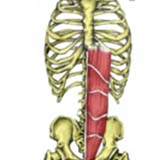
Rectus Abdominis is the most superficial of the abdominal muscles. It is this muscle that forms the six-pack shape!
- Origin: Crest of the pubis.
Pubic symphysis. - Insertion: Xiphoid process (base of the sternum).
5th,6th, and 7th costal cartilages. - Actions: Flexes lumbar spine.
- Innervation: Ventral rami of thoracic nerves.
- Daily uses: Moving from lying to sitting.
- Example strengthening exercises: Crunches or sit-ups.
- Example stretches: Abdominal stretch.
Quadratus Lumborum
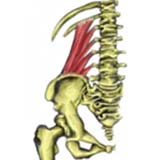
The quadratus lumborum or QL is a common cause of back pain which is to one side and comes on after lifting or twisting.
- Origin: Posterior iliac crest.
Iliolumbar ligament. - Insertion: Twelfth rib.
Transerve processes of L1-L4. - Actions: Lateral flexion (side-bends) of the trunk.
- Innervation: Ventral rami of the subcostal nerve.
Lumbar nerves. - Daily uses: Bending sideways to pick something up.
- Example strengthening exercises: Side bends.
Multifidus
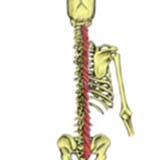
Multifidus is a series of small muscles which travel up the length of the spine. It is an important muscle in the rehabilitation of Gilmore’s Groin and lower back pain.
- Origin: Posterior surface of the sacrum. Articular processes of the lumbar vertebrae. Transverse processes of the thoracic vertebrae. Articular processes of C3-7.
- Insertion: Each part of the muscle inserts into the spinous process 2-4 vertebrae higher than its origin.
- Actions: Extension. Lateral flexion. Rotation of the spine.
- Innervation: Dorsal rami of the spinal nerves.
- Daily uses: Maintaining good posture of the spine.
- Example strengthening exercises: Dorsal raises.
- Example stretching exercises: Back arch stretch.
